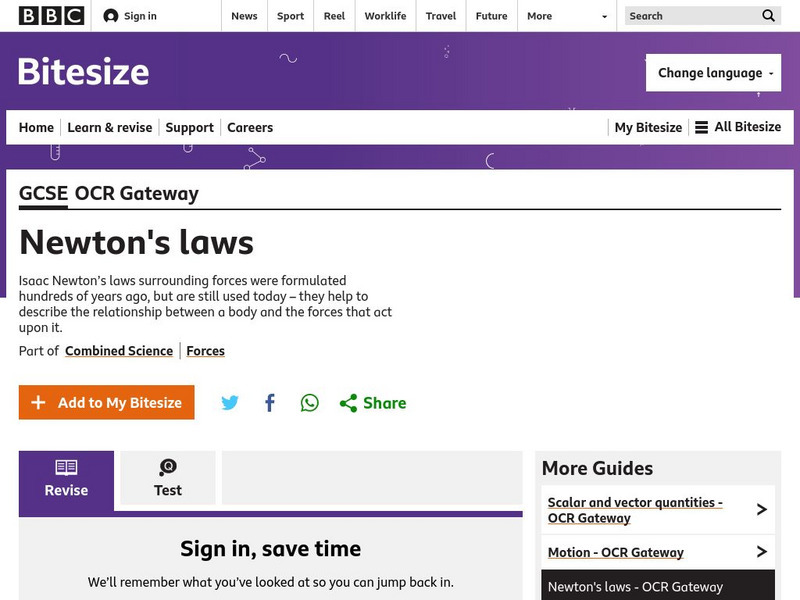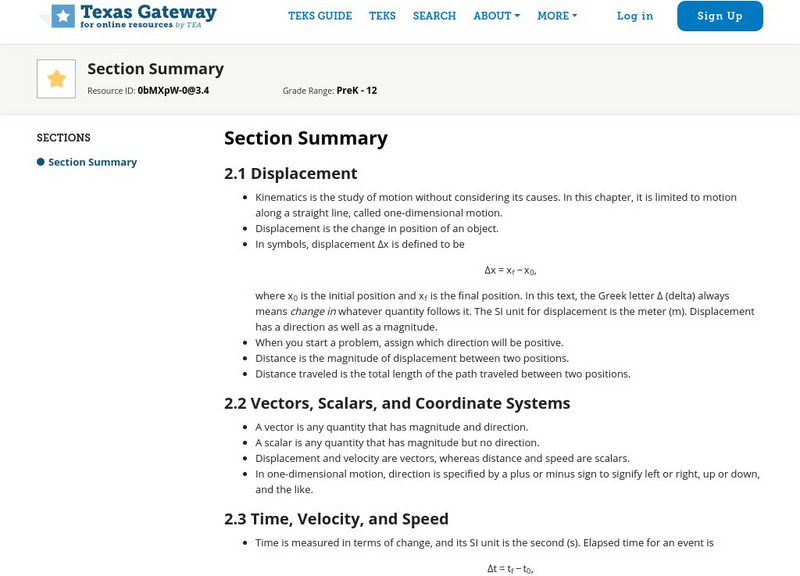Curated OER
Force and Acceleration
In this force and acceleration worksheet, students solve 3 problems about moving objects, the forces working against them, the mass and their acceleration. Students determine if 6 statements about a falling elephant and a falling feather...
Georgia Department of Education
Ga Virtual Learning: Linear Motion
A learning module where students gain an understanding of the relationships between the different kinds of motion. Students will be able to explain free-fall motion and use kinematics equations to calculate problems involving falling...
TED Talks
Ted: Ted Ed: If Superpowers Were Real: Super Strength
Find out if it is scientifically possible to have super strength. In this series, creator Joy Lin tackles this and six other superpowers and reveals just how scientifically realistic they can be. [4:05]
Science Buddies
Science Buddies: What Goes Up, Must Come Down
Standing on a balcony near the top of the 179-foot tall Tower of Pisa, a young scientist dropped two iron balls into the crowd below. The scientist, young Galileo, was not trying to knock his fellow professors on the head, but was trying...
Texas Education Agency
Texas Gateway: Kinematics: Falling Objects
By the end of this section, you will be able to describe the effects of gravity on objects in motion, describe the motion of objects that are in free fall, and calculate the position and velocity of objects in free fall.
Concord Consortium
Concord Consortium: Stem Resources: Was Galileo Right?
Do heavier and lighter objects fall at the same rate? Galileo hypothesized that objects fall at the same rate regardless of their mass. Complete this module to find out if Galileo was right by comparing position-time and velocity-time...
Texas Instruments
Texas Instruments: Falling Objects
In this activity, Students can use a Motion Detector to measure distance and velocity.
TeachEngineering
Teach Engineering: How Do Things Fall?
Students learn that it is incorrect to believe that heavier objects fall faster than lighter objects. By close observation of falling objects, they see that it is the amount of air resistance, not the weight of an object, which...
Discovery Education
Discovery Education: Physical Science: Gravity Gets You Down
In this lesson, students make predictions about falling objects of different sizes and masses to learn about gravity and air resistance. Includes audio vocabulary list and extension activities.
BBC
Bbc: Gcse Bitesize: Newton's Laws
This lesson focuses on Newton's Law for falling objects including terminal velocity, the three stages of falling, a diagram showing what happens to the speed of a skydiver from airplane to ground, velocity-time graphs for falling...
Texas Education Agency
Texas Gateway: Kinematics Section Summary
This is a summary of the main topics for AP Physics Chapter 2 Kinematics. These include Displacement; Vectors, Scalars, and Coordinate Systems; Time, Velocity, and Speed; Acceleration; Motion Equations for Constant Acceleration in One...
PBS
Pbs Learning Media: Galileo: His Place in Science
Einstein called Galileo the "father of modern physics." This media-rich essay from the NOVA Web site looks at Galileo's quest to understand the mathematics of motion.
NASA
Nasa: Beginner's Guide to Aerodynamics
Includes exhaustive information and a wealth of activities pertaining to aerodynamics and the physics of flight.
Concord Consortium
The Concord Consortium: Molecular Workbench: When a Ladder Falls
View an animation of a ladder falling due to the force of gravity.















